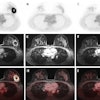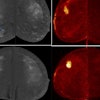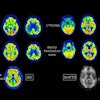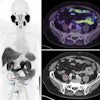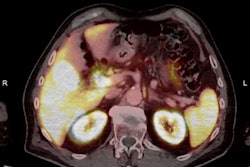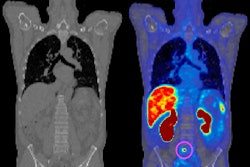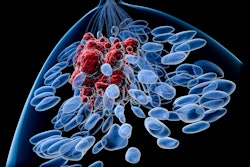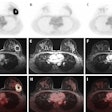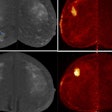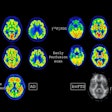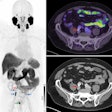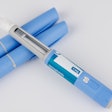Reducing average injected dose and uptake time in prostate-specific membrane antigen (PSMA) PET/CT can lead to improved patient throughput, as well as boosting patient access to this technique, according to Irish researchers.
In a poster presented at EuroSafe 2025, Dr. Jane Burns and colleagues from the radiology department at Dublin's Mater Misericordiae University Hospital noted that their hospital often provides PSMA PET/CT using the F-18 PSMA-1007 radiotracer. However, access to the technique in Ireland is often challenging, and long waiting lists and high costs have led to patient referrals to the U.K. Thus, staff have worked hard to reduce average injected doses and uptake times to boost throughput and keep the procedure accessible to more patients.
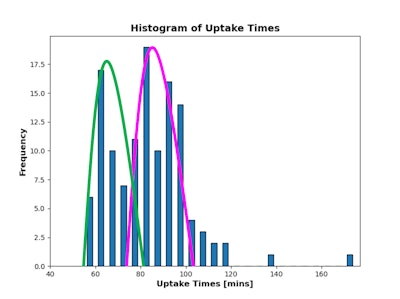 Histogram of uptake times for the Dublin group's patient cohort.All figures courtesy of Dr. Jane Burns, Prof. Martin O'Connell, et al, presented at EuroSafe 2025.
Histogram of uptake times for the Dublin group's patient cohort.All figures courtesy of Dr. Jane Burns, Prof. Martin O'Connell, et al, presented at EuroSafe 2025.
The Dublin team aimed to compare their current imaging protocol, established in 2022, with the European Association of Nuclear Medicine (EANM)'s 2023 guidelines. In addition, they wanted to assess if variations in uptake time had detectable effects on perceived image quality, as well as establish dose reference levels for F-18 PSMA-1007 PET for high-quality diagnostic CT.
Study logistics
The researchers performed a retrospective chart review of 123 F-18 PSMA-1007 PET/CT studies undertaken between September 2023 and September 2024. All patients were imaged on a Siemens Healthineers Biograph Vision 450 digital PET/CT scanner.
Patient age, patient weight, study indication, and total injected activity were recorded. The age range was between 48 and 82, with a mean age of 68.2; patient weights varied between 56 kg and 139.5 kg, with a mean weight of 83.4 kg. Uptake time, diagnostic image quality, and acquisition protocol were also recorded. In addition, any complications arising during imaging were noted.
The images were also graded on image quality on a 5-point Likert scale in three categories: an overall image quality score indicating if the image was acceptable for diagnostic purposes, a score for the ability to identify lesions, and a score for the perception of noise within the image.
While one-third of the patients were within the EANM recommended uptake time range of 90 to 120 minutes, 65% of the cohort had an uptake time of less than 90 minutes, and two (1.5%) patients had an uptake time greater than 120 minutes.
There were other differences between the EANM recommendations and the data from the Dublin hospital: the injected doses per kilogram in the review were lower than the EANM recommendations of 3 to 4 MBq/kg, with 100 patients receiving a dose of less than 3 MBq/kg, and a mean dose of 2.67 MBq/kg. One patient received a dose greater than 4 MBq/kg. Only 17.9% of the patients in the cohort received the 3 to 4 MBq/kg dose recommended in the EANM guidelines, the authors wrote.
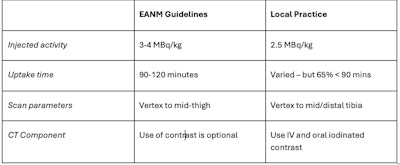 Table comparing current practices at the Mater Misericordiae Hospital with EANM guidelines.
Table comparing current practices at the Mater Misericordiae Hospital with EANM guidelines.
T-test results showed no statistically significant differences in the Likert scores for image quality for different uptake times (60-70 minutes and 90-100 minutes), with all of the studies being of good diagnostic quality, the authors wrote. Liver signal-to-noise ratio (SNR) calculated at both 60-70 minutes and 90-100 minutes showed no statistically significant difference, either. While there was a greater range of liver SNR for images scored between 3 and 3.5, there were no statistically significant differences between the 60-70 minute and 90-100 minute uptake time groups using either the Likert scores or liver SNR as metrics.
The authors concluded that even with lower average doses and uptake times than those recommended by the EANM guidelines, the diagnostic images produced were still of high quality. However, they added that the hospital has a newer digital PET/CT scanner that makes it possible to use lower injected doses; the results of their review might not hold true for departments using older analog equipment.
They concluded that a consistent protocol in line with EANM guidelines should be implemented in the future.
Read the poster here. The co-authors were M. Fitzsimons, J. Hunter, D. Caldwell, P. Cunningham, M. J. O'Connell, E. Loughman, P. Gilligan.

